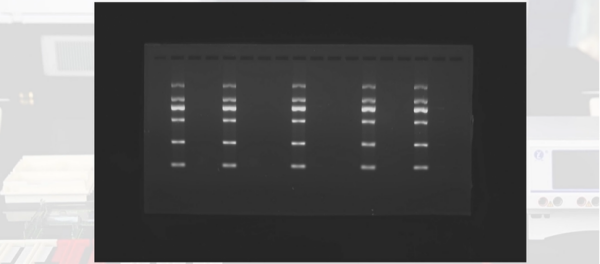Experimental Principle
Agarose is a natural polymer with long-chain molecules that can form rigid pores. The size of the gel pores depends on the concentration of agarose. DNA molecules carry a negative charge in an alkaline buffer and migrate toward the positive electrode under an applied electric field. During electrophoresis in agarose gel, DNA molecules are influenced by both charge effects and molecular sieving effects. DNA fragments of different molecular weights and conformations migrate at different rates, resulting in distinct bands.
Experimental Procedure
Gel Preparation
Determine the agarose gel concentration based on the DNA fragment size. Weigh the appropriate amount of agarose powder and dissolve it in TAE/TBE buffer. Heat in a microwave for about 1 minute (adjust time based on volume), then remove and add gel dye. Mix well and pour into the casting mold.
Note: The buffer is either Tris-acetate-EDTA (TAE) or Tris-borate-EDTA (TBE). These buffers maintain DNA in a deprotonated and soluble state under slightly alkaline conditions. EDTA is a chelating agent that inactivates nucleases that could damage the DNA being analyzed.
Gel Casting
Select the appropriate gel casting mold and comb. Gently pour the dyed agarose gel solution into the mold, checking for bubbles. If bubbles form, pop them before the gel solidifies, as they can affect results. Note: Pour slowly to avoid bubbles.
Mixing Samples with DNA Loading Buffer
Mix the samples with loading buffer containing bromophenol blue. The loading buffer helps track sample’s migration.
Sample Loading
Once the gel solidifies (opaque, ~20–30 minutes), carefully remove the comb. Place the gel in the electrophoresis chamber with wells near the negative (black) electrode. Fill the chamber with running buffer (TAE/TBE) until the gel is submerged by 1–2 mm. Load samples into the wells using a pipette, avoiding overflow.
Gel Electrophoresis
Ensure electrodes are correctly connected (reverse polarity will cause samples to run into the buffer). Set the voltage to 4–5 V/cm and run for 30–60 min (adjust based on gel percentage and fragment size; typically 120 V, 35 min). DNA migrates from the negative to the positive electrode. After electrophoresis, disconnect the power supply.
Precautions
l Agarose must be dissolved at high temperatures (e.g., microwaved until fully dissolved). Cool to ~60°C before adding DNA dyes (e.g., ethidium bromide) to avoid bubbles and dye degradation. Perform this step in a fume hood, as some dyes are toxic and volatile.
l Choose agarose concentration based on target DNA size: lower concentrations for larger fragments (e.g., 0.7% for >1 kb), higher concentrations for smaller fragments (e.g., 2% for <100 bp).
l Use fresh TBE or TAE buffer at the correct concentration. Buffer ionic strength and pH directly affect separation efficiency and migration speed.
l Add loading buffer (containing glycerol/sucrose for density and tracking dyes) to DNA samples before loading to ensure they sink into wells.
l Optimal voltage is 5 V/cm. High voltage speeds up electrophoresis but causes band diffusion; low voltage prolongs runtime and may lead to sample diffusion.
l Monitor electrophoresis time to prevent bands from running off the gel. A timer is essential for precise control.
l Do not exceed 50% of the conical flask’s volume when preparing agarose gel solution.
l Swirl the flask occasionally while heating to prevent agarose from settling at the bottom.
l Avoid damaging the gel near the comb teeth to prevent sample leakage during loading.
l Lower gel concentrations resolve larger fragments; higher concentrations resolve smaller fragments.
l When observing under UV transillumination, minimize exposure to prevent DNA damage. Limit UV exposure during gel extraction to reduce DNA nicking.
l Wear protective goggles when viewing under UV light to avoid eye damage.
Beijing Liuyi Biotechnology Co., Ltd. (Liuyi Biotechnology) has over 50 years of expertise in manufacturing electrophoresis instruments. With a dedicated technical team and R&D center, we provide reliable and comprehensive production, from design to inspection and warehousing. We offer a full range of products, including:
- Electrophoresis Cells (Tanks/Chambers)
- Electrophoresis Power Supplies
- Blue LED Transilluminators
- UV Transilluminators
- Gel Imaging & Analysis Systems
In addition, we supply other laboratory instruments such as PCR machines, vortex mixers, and centrifuges.
If you are considering purchasing our products, please don’t hesitate to reach out. You can contact us via email at sales@ly.com.cn or info@ly.com.cn. Alternatively, feel free to call us at +86 15810650221, add us on WhatsApp at +86 15810650221, or connect with us on WeChat at 15810650221.
Please scan the QR code to add us on WhatsApp or WeChat.
Post time: Jul-09-2025










